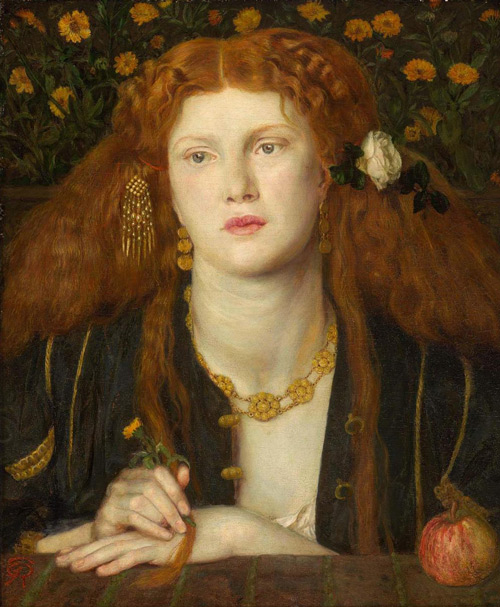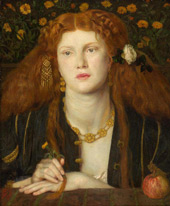Bocca Baciata (Lips That Have Been Kissed) 1859 By Dante Gabriel Rossetti
Dante Gabriel Rossetti painted Bocca Baciata in 1859. It is one of the most famous Dante Rossetti paintings.
The painting represents a turning point in the artist's career. As the first of several portraits depicting single-seated female sitters, it marked the beginning of Rossetti's unique signature style.
Moving away from Rossetti’s earlier style (highly influenced by Medieval artwork and culture), the painting is more Venetian in its sensibilities. The careful handling of paint, opulent color palette, and luxurious treatment of the woman’s red-golden hair create a truly sensual and captivating image.
Who is the woman in Dante Rossetti's painting?
Dante Gabriel Rossetti's portrait model is Fanny Cornforth, a professional artistic model from Sussex, England. She gazes out of the pictorial frame, perhaps at Rossetti or a mirror reflecting her beauty.
For Rossetti, Fanny Cornforth (born Sarah Cox) represented the platonic ideal of beauty. Her skin is pale white and almost translucent, while her rounded red lips hint at the artist’s longing.
Adding various opulent decorative touches (such as luxurious fabrics, flowers, and jewelry) only adds to his visual and visceral enjoyment. It invites the viewer to enjoy Cornforth and the painting in equal measure.
Despite this romantic background, Cornforth performed the more mundane role of housekeeper for Rossetti. She adopted this role after the death of his wife, Elizabeth Siddal.
Nonetheless, Rossetti’s depictions of Cornforth are notably more voluptuous and sensual than his paintings of other lovers and muses, such as Jane Morris and Elizabeth Siddal.
Rossetti's brother (William Michael Rossetti) praised Cornforth’s beauty. At the same time, however, her lower-class upbringing (as the daughter of a blacksmith) shocked Rossetti’s contemporaries. His brother further commented she had no “charm of breeding, education or intellect.” Many of Dante Rossetti’s friends and family held similar opinions and pressured the artist to cease the relationship.
What inspired Rossetti's Pre-Raphaelite painting?
In depicting this idealized beauty and sensuality, Rossetti utilized sixteenth-century Venetian masterpieces as inspiration, especially the work of Titian.
As Rossetti’s mistress and model, Cornforth inspired some of his most sensual artworks. As his artistic muse and general housekeeper, she also became a creative collaborator on many Dante Gabriel Rossetti paintings during the 1860s.
Cornforth appears in multiple portraits of this era, for instance, Fair Rosamund (1861), Lady Lilith (1867), Found (1869), and The Holy Grail (1874)
In a letter written to the Scottish artist William Bell Scott, Dante Rossetti describes trying to master the art of painting skin. However, he identified a self-perceived fault (that of stippled brushwork in the flesh), aiming instead for a fuller and rounder representation in Bocca Baciata.
Rossetti even accused the “old good painters” of a similar flaw. While their artworks were “masterpieces for color and execution”, Dante Rossetti felt the flesh tones lacked reality. Inspired by this challenge, he redoubled efforts in Bocca Baciata with stunning results.
What does Bocca Baciata mean?
The painting’s title translates from Italian as “mouth that has been kissed”.
This saying came from an Italian proverb inscribed by Rosetti (in Italian) on the back of the artwork. A rough translation reads, “the mouth that has been kissed doesn’t lose its fortune: it renews itself like the moon.”
Dante Rosetti was a highly proficient translator of early Italian Renaissance literature, with his poems frequently alluding to Italian folklore and culture.
It is likely he came across the proverb in Boccaccio's The Decameron. This 14th-century collection of short stories recounts the tale of Alatiel. Alatiel was a beautiful Saracen princess. Despite previous sexual relations (reportedly on ten thousand occasions with eight different lovers in four years), the King of the Algarve selected her as his virgin bride.
Consequently, although the painting marks a significant shift in Rossetti’s artistic style, it maintains his close literary interest and connections.
While the painting is an accomplished candid portrait in its own right, there are also multiple layers of allusion. Cornforth is depicted right at the front of the pictorial plane, close enough to reach out of the canvas. Despite this, her physical proximity contrasts with the psychological distance.
Cornforth gazes out of the picture, but she doesn’t look directly at us. Possibly hinting at separation or strife within the relationship, it’s a fascinating detail. On the other hand, Cornforth might be looking at the artist instead of the viewer, perhaps suggesting perceived ownership and closeness as a couple.
What style are Dante Rossetti’s paintings?
Bocca Baciata is a prime example of Rosetti’s Pre-Raphaelite paintings. Known as the Pre-Raphaelite Brotherhood, Rossetti co-founded the movement alongside leading avant-garde creatives such as John Everett Millais, William Holman Hunt, William Michael Rossetti, and Frederic George Stephens.
With seven members, the artists, critics, and writers prized great detailing in art. The painters (exemplified by Rossetti) favored intense colors and the complex compositions found in early Italian renaissance art.
Altogether rejecting the “mechanistic” approach of the later Mannerist movement, Pre-Raphaelites focused on classical poses and elegant pictorial depictions inspired by early Renaissance masters.
Possibly influenced by an earlier work by John Everett Millais (his Portrait of Sophie Gray), Rossetti’s Bocca Baciata radiates Pre-Raphaelite iconography. The inclusion of the apple in the bottom-left corner is particularly intriguing. The apple could reference original Biblical sin (depicted in the Book of Genesis), hinting at the pair’s tempestuous and often adulterous love affair.
Why was Lips That Have Been Kissed painted?
George Price Boyce commissioned the painting on 23 July 1859. However, Rossetti’s exact reasons for painting the portrait are shrouded in mystery.
Boyce was also a founding member of the Pre-Raphaelite brotherhood. As a close friend and frequent patron of Rossetti, Boyce happily lent the portrait to the Royal Academy in 1883 to further Rossetti’s name and publicity. Appearing in an Exhibition of Old Masters, the painting was a critical success.
Charles Fairfax Murray later bought the painting in 1887. It changed hands several times after that, purchased by Mrs. Edward Brandegee and later passed onto her son-in-law James Lawrence.
Lawrence donated the portrait in his will to the Museum of Fine Arts, Boston, USA. The painting remains proudly displayed in their fine art collection to this day.
Buy fine art reproductions of pre raphelite paintings by Dante Gabriel Rossetti and other famous portrait painters.
We offer a 100% money back guarantee or replacement service. If for any reason you are dissatisfied with your painting please contact us within 7 days of receipt, advising the reason you are unhappy and we will provide you with all the information you need for its return or replacement.
We ship free to anywhere in the world via FedEx or DHL expedited service with online tracking.
Your painting will be shipped rolled in strong plastic tubing, ready for stretching and/or framing locally. This is the conventional method of transporting hand-painted oil on canvas. Learn more about how your painting is shipped.
We are able to offer a framing service intercontinental U.S. Please contact us if you would like a quotation. Alternatively, should you prefer, we can recommend a framer in your area.
Notes About Your Painting
Please note that replica oil paintings are finished with an additional 10cm (4") of extra canvas on all sides, allowing ample surplus canvas for stretching and framing.
Recently Viewed:
Cannot Find What You Are Looking For?
Reproduction Gallery Information
Customer Service
(Send Us A Message)
Tel: (503) 937 2010
Fax: (503) 937 2011







